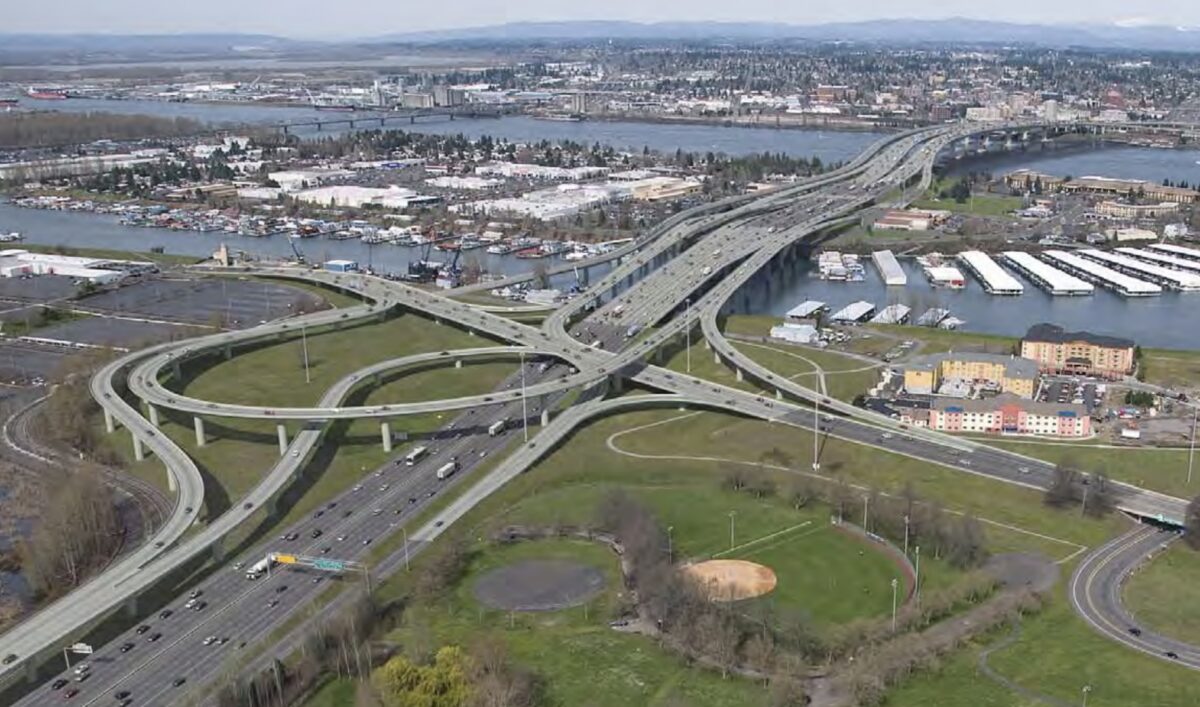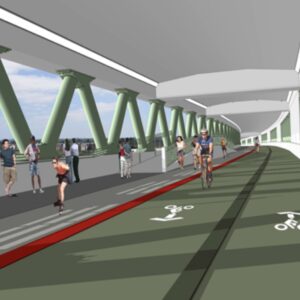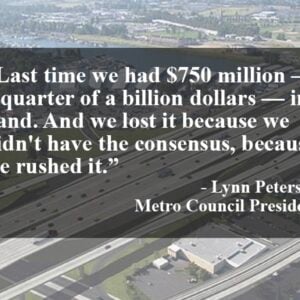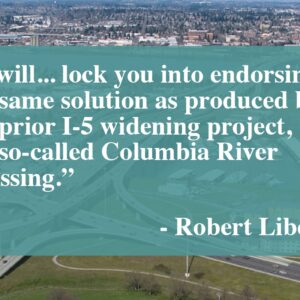
(Note: This is Ryan Packer’s first article for BikePortland. They’ll cover the effort to expand I-5 and replace the Interstate Bridge between Oregon and Washington.)
At the beginning of this year, Program Administrator Greg Johnson said the project team was about to “start running” to achieve the goal of construction by 2025. But hurdles are popping up faster than anticipated.
In 2013, when Oregon’s then-Governor John Kitzhaber issued a public statement to announce the Columbia River Crossing highway expansion project was dead, he pointed the finger at one institution: the Washington State Senate. That year, a $10 billion transportation funding package had failed to pass after squeaking through the Washington State House of Representatives. “I am extremely disappointed that our legislative partners in the Washington state Senate failed to address the clear and present safety and economic need for this essential I-5 bridge.” Despite Oregon’s attempts to go-it-alone after the Washington legislature wouldn’t act, the fact that a deal couldn’t be reached that session was crucial to the project’s demise.
At the beginning of Washington’s legislative session this January, it looked like things had changed. Of numerous proposals for what a transportation package might look like, all of them included a huge earmark for the project. The 2013 allocation of $450 million had essentially doubled to $1 billion. This past Sunday the sun set on the 105-day session and only one chamber’s transportation package had been passed out of committee, much less received a floor vote.
But the CRC zombie refuses to die.
A handful of Washington lawmakers gave other members an incentive to come back to the negotiating table; two of the Democrats’ key pieces of legislation passed this session — a carbon cap-and-trade bill and a low-carbon fuel standard — both require a transportation package of some kind to pass in order to take effect. It’s against this background that the I-5 project is moving forward.
What form it takes — a carbon copy or a new mold — remains to be seen.
Advertisement
Between 2010 and 2020, when the Columbia River Crossing mostly sat dormant, waiting to be revived as the “Interstate Bridge Replacement program” (a misnomer since most the funding would expand five miles of the freeway), Washington and Oregon together gained nearly 1.4 million residents — more people than currently live in ten other states. Yet the question of how much of the environmental review process from that failed endeavor can be reused is the biggest question on the table right now. Attempts to add climate change and equity considerations directly into the project’s all-important “Purpose and Need” statement have been met with hesitation by the project team. Why? Because making those changes may prompt the Federal Highway Administration to consider the project significantly changed from the one it issued a Record of Decision on in 2011, which could trigger more analysis (and delays). On the other hand, if a carbon copy of those Purpose and Need statements are used, it’s likely to push the project closer to the previous — and highly controversial — design.

At a meeting of the project’s Executive Steering Group (made up of elected and agency heads from around the region) this week, some members expressed how much they’d like to avoid a do-over — a.k.a. “path four” in the chart above shared by the project team. The other paths an updated environmental review could take include no re-evaluation or one of two middle paths. Portland Bureau of Transportation Commissioner and ESG member Jo Ann Hardesty, who has already voiced a desire to add climate and equity language to the Purpose and Need, told the group she envisions going down paths two or three which would require a Supplemental EIS (environmental impact statement).
The discussion of Purpose and Need at the ESG is taking place well before any of the other issues that caused the original CRC to fall apart are even on the table, but that hasn’t stopped those issues from resurfacing elsewhere. Elected officials are already going back and forth via the press over the issue of whether the bridge will carry light rail after Rep. Earl Blumenauer told Willamette Week the project won’t happen without it. This prompted a reply from his Republican colleague from across the river, Rep. Jaime Herrera Beutler, who told Clark County Today: “This same stubborn, top-down attitude effectively killed the last I-5 bridge replacement effort.”
A vote to approve the Purpose and Need statements had originally been planned for late May. That vote has now been delayed. At the beginning of this year, Program Administrator Greg Johnson said the project team was about to “start running” to achieve the goal of construction by 2025. But hurdles are popping up faster than anticipated.

— Ryan Packer lives in Seattle and covers transportation issues as a senior editor at The Urbanist. Contact them at ryan@theurbanist.org
— Get our headlines delivered to your inbox.
— Support this independent community media outlet with a one-time contribution or monthly subscription.






Thanks for reading.
BikePortland has served this community with independent community journalism since 2005. We rely on subscriptions from readers like you to survive. Your financial support is vital in keeping this valuable resource alive and well.
Please subscribe today to strengthen and expand our work.
First, very exciting to have a new contributor, welcome Ryan!
Second, this project needs only 2 things: congestion pricing and an extension of the light rail into Vancouver. Rather than spending tens of billions of dollars on expanding I5 through all of Portland, we could probably get away with $500 million on toll equipment and ~$675 million on a new lightrail bridge (shot in the dark, 5x the cost of the tilikum bridge). I refuse to believe that this suggestion has not been voiced to every local & state leader, so I am left dumbfounded as to why said leaders want to choose the most expensive and least worthwhile option instead.
To be fair, the 1917 span will need to be replaced at some point, and i would be good to have a crossing that will not be destroyed in a subduction earthquake (counterweight lift span bridges are highly susceptible).
But half of the CRC budget was going to go to interchange reconstruction, and lane additions outside the actual crossing area. This is an incredible waste of our finite transportation dollars. A northbound span replacement (4 lanes so we can include HOV and utilize for 2-way 2-lane traffic after an earthquake) and a transit local access bridge downstream would enable the closure of the ramps on Hayden island (and the horrendous road design that goes along with it). All of this could be done for half the proposed cost of the CRC.
Or not. We have a bias against old things, sometimes it’s just bias.
They’ve done upgrades over the years and can continue to seismically strengthen it; when they studied seismic strengthening it came to about 5% of the cost of the CRC project. (Still $200 million, but that’s super-cheap compared to new construction and tear down of old).
That would free up hundreds of millions of dollars to build innumerable walking and biking safety projects, reducing pollution, increasing health, saving lives…
I definitely support much of the “Common Sense Alternative” proposal, but I question the statement that the vertical lift counterweight bridges can be seismically retrofitted to survive a Cascadia Subduction Earthquake. I can find examples of vertical lift bridges being retrofitted in places with risk of lower-intensity earthquakes, but I can’t find any examples of anyone claiming they can retrofit one of these bridges to survive 15 minutes of 9.0+ shaking. There are two big issues:
1. Mass of the counterweight. During sustained shaking, this mass will be constantly cycling the structure, eventually causing the members to yield and fail.
2. Foundation stability. The river bottom will most likely liquefy, so if the existing bridges are not anchored down to bedrock, they will most likely fail and bring the entire bridge down.
I can understand the desire to replace the bridges since they have tiny sidewalks, no bike facilities, no break-down shoulders, and lift spans. But they could just replace with a normal 6-lane bridge with shoulders, or maybe 8 lanes if they include bus-only or HOV 3+ lanes. There’s no need for this massive 12+ lane monstrosity that seemingly includes more auxiliary lanes than through lanes. If you need separate bridges for your auxiliary lanes, you should maybe rethink if you really need them. And there’s no need for all these new interchanges. Tolling would reduce demand enough to solve any congestion problems from having “only” 6 lanes, and bus rapid transit and light rail options would be available for people who don’t want to pay tolls or don’t feel like they can afford it (could also have low-income discounts on tolls). Also, a local bridge should serve Hayden Island, it’s stupid to have an interchange eating up half the island.
Ryan – good tight overview (as someone originally involved in portions of the CRC: bike ped facility and LRT station area planning.)
The last hour WA Senate issue was even more surreal…as it was the change of party by one member of the senate that flipped control and thus scuppered WA state’s local match (my memory). [Much of the CRC project foreshadowed what is now our national politics of demonization and lack of cross aisle conversations.] If the “DoTs” are triggered to reopen the ROD/ EIS, I do hope both departments and communities really re-examine the tunnel option (and a needed arterial bridge between Delta Park and Jantzen Beach. This critical design decision was “retired” too early in the process given what we all found out later about future bridge negative impacts: overall height, shipping barrier, downtown building demolition, etc.) [Imagine the bottom of the bridge being close to where the top of the current bridge is, etc.] And I hope that Oregon allows Washington to take the lead in many areas that their staff have stronger leadership experience with such as tolling management and highway tunnel work (Alaska Viaduct replacement).
I know Vancouver’s downtown would love to reclaim I-5 land (and reduced air and noise impacts) if the northern terminus of the crossing is a tunnel that exits at Kiggins Bowl…perhaps the southern terminus is a redeveloped Portland Meadows (the now closed horse racing track). These areas could include project funded housing and other community facilities…
Have the DOTs studied a tunnel? The obvious negative is the cost, but there are so many improvements. Utilize the existing bridge to Hayden Island for local access from Marine Drive. Add a transit and Ped bridge from Expo to downtown Vancouver, with a stop on Hayden. I-5 dives into a tunnel at Delta Park and emerges after Mill Plain (you’d want to get back above ground before SR-500 to avoid a costly interchange rebuild). All of the land for I-5 is now open for development, and you no longer have issues with airspace or shipping clearance.
What are the engineering/cost limitations of the tunnel option? How much was it investigated, and why wasn’t it considered?
My memory of the ‘tunnel / arterial bridge’ options that they were discarded very early on…~2006…so I doubt any deep design with cost analysis was done (might have only been a bullet point figure in an early presentation and rendering). The internal staff discussions that filtered down to us in transportation / public works was that “neither city wanted to be in the business of managing a local arterial bridge facility’. You might find more details deep in the CRC archive but I never saw any that I can think of at a meeting. And to be fair…neither DoT had any recent experience with a multi-mile tunnel in recent history then. They had a higher comfort level with highway type bridges. Plus there was strong reticence to skipping past the SR14, Mill Plain & Fourth Plain interchanges as the soonest surfacing was likely north of 33rd St. [But I say embrace these negatives as positives to liberate downtown Vancouver from its choking role as a highway intersection.] It will take some very creative analysis on the level of what was done to rethink access to OHSU…when the Portland Tram was proposed.
The Columbian looked back at the tunnel option in 2019…
https://www.columbian.com/news/2019/mar/10/interstate-5-tunnel-veterans-columbia-river-crossing-other-projects-explain-drawbacks-to-idea/?fb_comment_id=2703134323031943_2705613786117330
Good to learn the dumb arguments against tunnels from the article, thanks for the link.
Earthquakes: Bridges are also susceptible to damage from earthquakes, including the hundreds of viaducts for onramps and overpasses all along I-5, while US 26 already has a tunnel in Portland, and the Frasure River highway tunnel 300 miles north works just fine on highway 99. We have in fact figured out long ago how to engineer highway tunnels to survive earthquakes.
Traffic Speed: The assumption is traffic will move at the posted speed limit of 75mph (“interstate speeds”), but even the best scenarios have traffic congestion at the CRC that is so bad as to be grade D, lots of stop-and-go. So the notion that the tunnel would have to be gradual like the Chunnel with 2-mile approaches on either side is bunk; NYC-type river tunnels with steeper corkscrew approaches would work just as well given the expected traffic speeds.
Capacity: Same with bridges, if you need more capacity, either build more tunnels, or make them double-decker as on the new Swiss rail tunnels.
Rail & Light Rail: They have this wonderful new invention called subways, in use for the last 150+ years.
Hazardous cargoes and 40-ton battle tanks (plus bicycles and pedestrians): Keep the old bridges in place but restrict their use to bicycles and pedestrians only. Put retractable bollards at all ends to keep motor vehicles out. When there’s a (rare) need to move hazardous cargo or battle tanks that can’t go on trains, let the bollards down temporarily.
Hazardous cargo should be taking I205 anyway. This restriction exists for the sunset tunnels, and there are alternate routes.
By a redeveloped Portland Meadows, I hope you don’t mean another horse racing track. Horse racing kills thousands of horses per year, and even in states where it’s popular requires hundreds of millions in tax payer subsidization to keep solvent.
Portland Meadows is already long gone and is being redeveloped into an Amazon distribution center.
Thereby making the leap from abusing animals to abusing people…yay?
So, Oregonians should want to spend billions on this bridgestrosity to subsidize commuters to roll coal into Portland and clog local streets and parking and consume Oregon services without paying Oregon taxes?
Maybe you should talk to the people hiring all of these Northern interlopers.
Umm those of us that live in Washington but work in Oregon definitely pay Oregon Income Tax.
Thanks for the article, Ryan. Keep working on your subject-verb agreement, and read every word of every article aloud so you catch missing words.
The discussion of the tunnel in the comments makes me think that a tunnel is really needed – I wonder why that option was cast aside so early in the process. The proximity of PDX obviates a tall and beautiful bridge anyway. Look at many East-Coast cities and their tunnels under crucial waterways – I don’t see why the same arguments can’t be marshaled here.
Of course if really big thinking is on the table (as in the Biden infrastructure package), maybe someone will adopt my idea of moving the I-5 crossing to St Helens and turning the Dirty 30 into I-5. Demolish the 1917 span and turn the remaining span into a local bridge, with room for peds, bikes, and local mass transit.
Ryan makes a great point that this project really needs to be re-imagined from the ground up and not just re-started where they left off in 2010, which is obviously the expedient but misguided course of action.
Definitely. The tunnel option should be reconsidered. This project should make our city more livable. The Vancouver waterfront could easily be a model for the entire I5 area on both sides of the river. Instead of a loud, toxic, low land value area, a tunnel could make Hayden Island and Downtown Vancouver actually livable.
The location transfer of the I5 corridor as an interstate and replacement as multimodal boulevard could be possible if a tunnel option through St. Johns and another tunnel/bridge parallel to the Burlington Northern Railroad Bridge were considered. N. Portland would be an incredible place without the I5 cut.
The only people who find the CRC project “highly controversial” are activists who refuse to acknowledge that replacement is long overdue… while denying that our metro area’s transportation needs have not even remotely kept pace with growth.
As for politicians like Hardesty, I’m seeing all the engagement of a petulant child, angry that she was not given her preferred bureau assignment. Speaking of outdated & woefully inadequate stuff that needs to be replaced: our backwards form of city government.
Anyhow, it’s easy to call for “congestion pricing” from the perspective of an inner city, remote-worker privilege scenario. All it will amount to is a regressive tax against working class people. And I don’t care what side of the border you live on, it’s a raw deal for anyone whose livelihood requires driving to work.
Remind me, what’s the progressive tax that pays for the multi-billion dollar bridge you want?
Like Todd B. I have been watching this CRC madness for a long time. I served on the Governors’ I-5 Task Force (1999-2002) and voted NO on their final report. At some point a few years later I wrote a memo to a Clark County Commissioner suggesting a tunnel. Here are a few points (note that the historic bridges retrofit would have to include modern bike and pedestrian facilities):
A tunnel under the Columbia River (including Oregon Slough/Portland Harbor) may offer a simple…even elegant, data based and cost effective solution to this transportation challenge…separating through trips from local ones.
The Tunnel option simplifies construction logistics, has fewer impacts on river traffic, water quality, fish or air traffic. The conversion of the existing Interstate Bridges, retains historic structures, re-using them in new ways to accommodate local vehicle and transit trips. Removal/conversion of existing freeway segments captures valuable land adjacent to transit, arterials and the River for re-development…commercial, industrial or residential/retail.
Original Interstate Bridge, built in 1917, had four traffic lanes with streetcar tracks…you could take the Union Avenue streetcar to downtown Vancouver! With the construction of I-5 through North Portland and across the River, a second bridge was built and together the twin bridges became I-5…the arterial and transit connections were lost!
Well said, and spot on!
Thanks for the historical reference to the Governor’s I-5 Task Force. And THANK YOU for your involvement in this important issue.
I too favor “recycling” our historic bridge, making it a “local” connection between the communities.
A tunnel would offer faster trips for “express” through traffic, as you noted, and the current two bridge structures could happily serve the community for local trips. The oldest steel bridge in the nation is roughly 40 years OLDER than the original structure of the Interstate Bridge. The Eads Bridge still serves the St. Louis community crossing the Mississippi River. Our Interstate Bridge could do the same.
One thing that many of us suggested back at the CRC 1.0 time frame was to go ahead and start tolling the bridge immediately so that we could better understand the actual demand that would exist under a tolling regime. We could have 10 years of data now, and a pot of money that could have been used to finance some of the no brainer improvements like moving the swing gate on the railroad bridge to greatly reduce the need to lift the bridge.
Glad BikePortland is given this rebranded CRC farce top billing, and thanks to Ryan Packer for his fine first story.
Re a comment suggesting that opponents are just “activists,” I’ll point out that there are today 16 lanes across the Columbia for motorized traffic, one lousy bike facility and two worse sidewalks. No transit dedicated space at all…except for the outside lane on I-205 which I noticed yesterday! We need a little more balance across the River, more options.
Between a third and half of the traffic on I-5 is local…maybe we need a “Broadway Bridge across the Columbia, not a massive five miles of over designed freeway (plus bridge!)
The old bridges are built on big, old growth Doug Fir pilings, which are as intact as the day they were sunk; there are surely some upgrades and have been many to date to keep the two bridges in service. Converted to arterial traffic all the seismically at risk approach ramps and such can be removed for true boulevard treatments and massive redevelopment of priceless riverside property. Put the freeway in a tunnel paid for with tolls.
When the big one hits, its the RR bridge that will really leave us stranded; that is the bridge that needs to be upgraded, widened for higher speed passenger and commuter rail.
Joe Cortright has some fine discussions of the equity issue of tolls or congestion pricing; see http://www.cityobservatory.org to learn more. But there is no question that the construction of the Portland (and other US cities’) freeway networks through poor and working class neighborhoods was and continues to be a virtual assault on those living within a quarter mile of the “toxic rivers” that freeways are. Freeways should be removed from cities, period…removals in other cities have turned out to be No Big Deal!
In 2008, the SW WA Regional Transportation Council (RTC) published a “Visioning Study” which identified the need for two new transportation corridors and bridge in the next 50 years. They offered two options for each bridge location, one bridge west of I-5 and the other east of I-205.
One of those options in particular, was perfect to serve as a local bridge, serving the Port of Portland truck traffic and getting it off I-5 and the Interstate Bridge.
As you noted, a significant amount of the traffic crossing the Interstate Bridge location is getting off I-5 inside the 5-mile “bridge influence area”, and would be well served with a “local” bridge connection.
The Interstate Bridge Replacement Program (IBRP) has come out and said they will plan for “3 through lanes” on their bridge, plus an unspecified number of auxiliary lanes.
https://www.clarkcountytoday.com/news/ibrp-plans-a-three-lane-replacement-interstate-bridge/